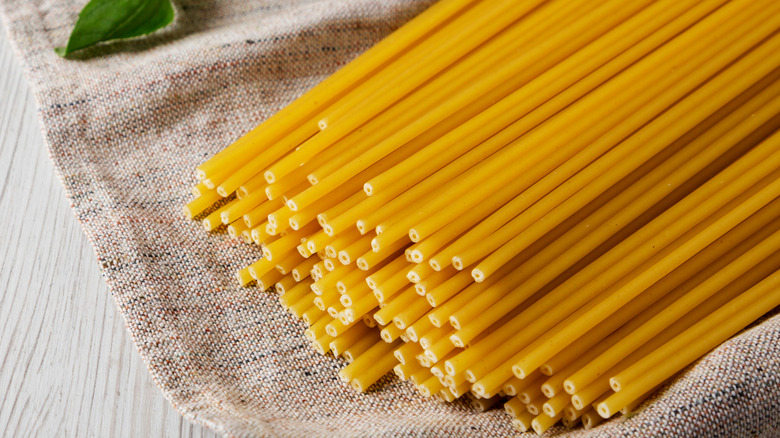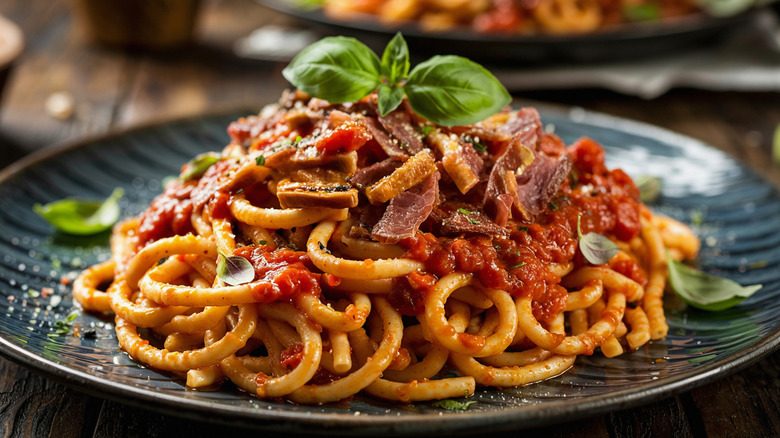Here's Exactly How Bucatini Pasta Is Made
It's estimated that there are over 350 pasta shapes originating from Italy, each a different size, shape, and thickness — affecting how they interact with sauces and other ingredients. Bucatini is one of the more well-known shapes. To learn the ins and outs of how bucatini is made, Food Republic consulted Evan Churchill, chef de cuisine at Osteria Lupo, who revealed that bucatini's "hollow center is what puts it in a league of its own."
Bucatini originated in the Lazio region of Italy, which is home to the iconic capital, Rome, where there's a deep affinity towards this pasta shape. The name is derived from the Italian word "buco," meaning hole — referencing the pasta's distinctive hollow center. According to Evan, this hollow center "gives [bucatini] a really unique texture and allows sauces to stay on both the outside and inside."
But how does the pasta get that distinctive hollowness? Evan explained, "The hole is formed during extrusion, when the dough is pushed through a special die with a pin in the center." This pasta-making technique dates all the way back to Medieval times, where pasta makers lacked an efficient drying system, resulting in long cooking times and uneven drying, which affected the taste and texture of the pasta. Bucatini was the inventive solution to combat this, with the hollow center allowing the pasta to be cooked from the inside out, resulting in more even doneness. This innovative approach is also why we have other iconic hollow pasta shapes like rigatoni, penne, and macaroni, to name just a few.
What sauces pair best with Bucatini?
Although bucatini is widely enjoyed in Rome, its traditional pairing, bucatini all'Amatriciana, originated in Amatrice. This small town nestled in the Apennine mountains has a rich history of shepherding and rustic, hearty cuisine. Amatriciana is a bold, flavorful sauce made from guancale (cured pork cheek), tomatoes, Pecorino Romano, and a touch of black pepper, capturing the simplicity and heartiness of central Italian cooking.
Bucatini is especially well suited for this rich sauce, as its "sturdiness makes for a perfect bite, while the hollow center holds extra sauce," Evan Churchill told us. This ensures that every bit of pasta is rich, well-coated, and flavorful, making it the perfect companion for this classic. "It gives that perfect pasta-to-sauce ratio each time. This particular shape of pasta really takes the meal to the next level and allows it to all come together on the palate," Evan added.
Bucatini's unique structure also makes it ideal for other robust, oil- or fat-based sauces. Quintessential Roman pasta dishes like cacio e pepe (which also happened to be Anthony Bourdain's favourite pasta), made with Pecorino Romano and black pepper, and gricia, a cheese and guanciale-based precursor to carbonara, are held beautifully in bucatini's tubular shape. Even creamy, egg-based sauces like carbonara excel when paired with bucatini, which distributes the rich flavors evenly. Bucatini is also very versatile and has uses outside of being a vessel for pasta sauces. For other uses for bucatini, you could try having it add structure to your next pasta salad.


